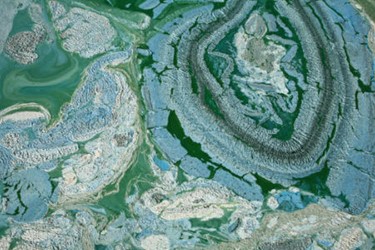WRF Hosts Capitol Hill, State-Of-The-Science Briefing On Harmful Algal Blooms
By Kelsey Beveridge

Toxin-producing cyanobacterial blooms are a growing concern for water utilities across the world that use surface water supplies. Increased urbanization and demand for higher agricultural productivity is leading to increased nutrient loading of source waters, which also contributes to more frequent and intense cyanobacterial blooms in water sources. Cyanobacterial blooms (also referred to as harmful algal blooms — cHABs or HABs) can result in the release of cyanotoxins (or algal toxins). Several studies have investigated the toxicity of cyanotoxins and documented their human health effects, including gastroenteritis, liver damage, liver cancer, and neurotoxic effects. To make informed decisions about how to limit exposure to cyanotoxins, utilities need information to select and implement a comprehensive and technically sound management approach. The Water Research Foundation (WRF) has been actively involved in developing effective innovative solutions to help utilities address this challenge and protect public health.
Background
On June 17, 2015, the U.S. EPA issued 10-day Health Advisories (HAs) for states and utilities to protect the public from cyanotoxins in drinking water. For children younger than school age, the HA was set at 0.3 µg/L for total microcystin and 0.7 µg/L for cylindrospermopsin. The corresponding values for adults are 1.6 µg/L and 3.0 µg/L, respectively. Although not enforceable, the published HAs are intended to trigger utility actions including increased monitoring, development of treatment strategies, and public notification of “do not drink/do not boil” advisories. The HAs’ very low thresholds could result in frequent exceedances, placing a financial burden on utilities and causing loss of public confidence in the safety of drinking water. In addition, the HAs have different advisory level thresholds for two different age groups, creating a challenge for effective and concise communication about risk.
Although there are no federal standards for cyanotoxins, several cyanotoxins have been listed in Contaminant Candidate Lists (CCL1, 2, 2, and CC4). The EPA has also provided recommendations on how utilities can monitor and treat drinking water for cyanotoxins, including the Fourth Unregulated Contaminant Monitoring Rule (UCMR4), which includes 10 cyanotoxins/groups. Additionally, the EPA was charged with developing a “strategic plan for assessing and managing risks associated with algal toxins in drinking water provided by public water systems.” The strategic plan was released on November 19, 2015 and identifies the EPA’s ongoing and planned activities in the following areas:
- Summary of current state of the science and health effects
- Evaluation of risks to human health in drinking water systems
- Development and maintenance of a list of cyanotoxins
- Recommendations on feasible treatment options
- Better understanding of factors that cause cyanotoxins
- Recommendation for source water protection measures
Congressional Briefing
To provide decision-makers and congressional staffers with the state of the science on cHABs, WRF hosted a congressional briefing in Washington, D.C. on June 28. Four speakers representing utilities and research groups spoke on their experience with cHABs, steps taken to address the issue, and additional needs moving forward. The event had a diverse set of attendees representing federal organizations, utilities, water sector organizations, and congressional staff. WRF provided a livestream on Twitter that has had nearly 800 views since the briefing.
Frank Greenland, Director of Watershed Programs at Northeast Ohio Regional Sewer District, addressed water quality issues in Lake Erie and algal growth as a result of runoff and excess nutrients. They have started daily sampling to look for toxins, begun communicating to beach managers and the public about health alerts, and educating the public on how to reduce nutrient runoff and erosion.
Alex Margevicius, PE, Commissioner of Cleveland Water, described how monitoring and water treatment plant improvements have provided a stronger understanding of lake conditions, and ultimately better prediction and treatment for cHABs in water treatment systems.
Peter Fernandez, Public Works Director for the City of Salem, OR, has dealt with nutrient loading and cHABs in Detroit Lake due to soil erosion from forest fires and logging operations. He emphasized the importance of clear communication with the public to reduce panic for high levels of contaminated water and clear description of risks.
Laura Weinrich, Principal Scientist from American Water, discussed the investments American Water is making to pilot emerging treatment technologies to ensure utilities are well prepared for a cHABs event.
While each speaker’s organization has unique areas they are addressing with respect to presence of cHABs in their drinking water supplies, they all identified the need for more research to reduce cHABs at the source rather than at the treatment facility, and the potential effects to the aquatic environment and public health. All spoke of the importance of securing financial and technical support to advance testing and innovative research. The speakers recommended that innovative techniques and early warning systems (e.g., satellite data imagery, on-line sensors) be developed to help facilities make adjustments ahead of time. The water sector faces similar challenges across regions but needs more clarity on the exact issues associated with harmful cyanotoxins to appropriately communicate risks and manage the consequences. Overall, attendees came away with a new sense of how the water sector is taking the lead and managing cHAB events, and opportunities to improve the state of knowledge through advancing research needs.
WRF has many other projects supporting a broad cyanotoxin portfolio to help understand the potential consequences to public health and the aquatic environment, and will continue to develop and support research findings. WRF has sponsored research on cHABs for over 25 years, collaborating with federal partners such as the National Oceanic and Atmospheric Administration, the U.S. Geological Survey, and the EPA, as well as water sector leaders. Much of the research is intended to help utilities understand detection, treatment methods to remove toxins, and guidance materials to help utilities identify best options for them.
Watch the full briefing and learn more about WRF’s cyanotoxin and cyanobacteria research.
